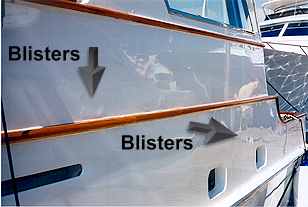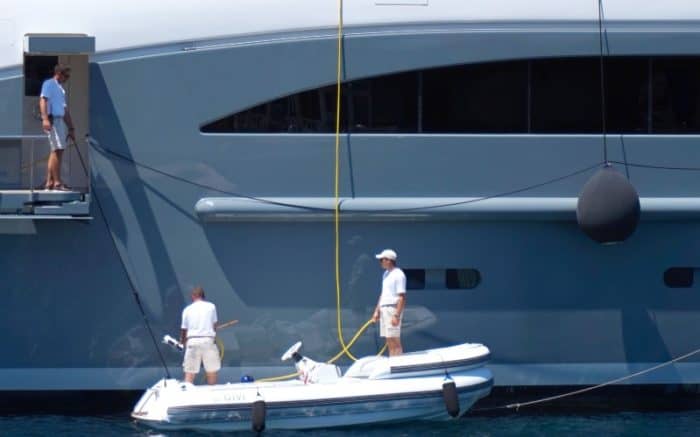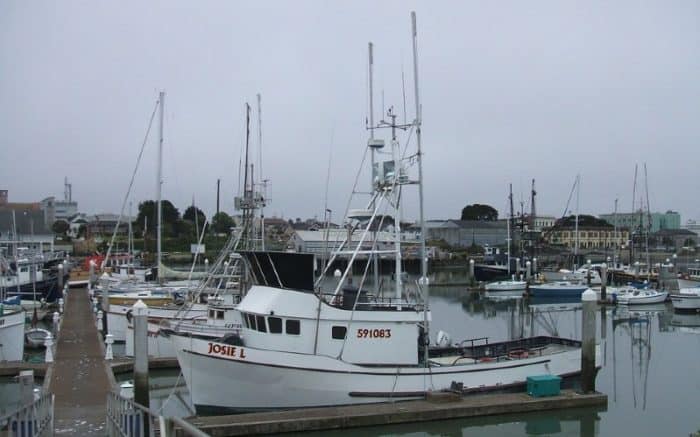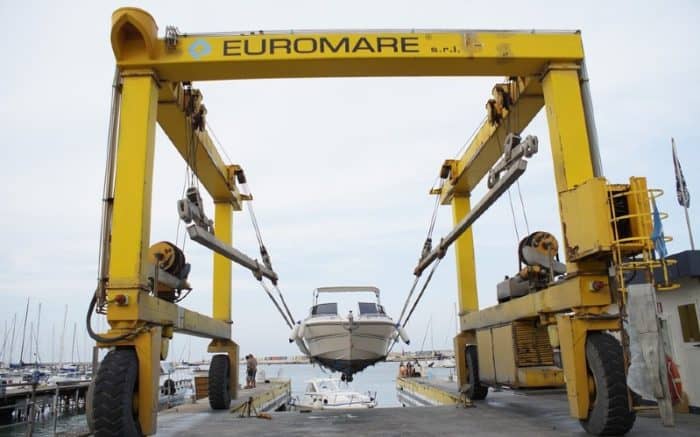How to Repair Boat Hull Blisters AKA Chicken Pox
Boat blisters, also known as chickenpox, can be a real pain to repair. And a real stressor. A boat is supposed to be waterproof. That’s the defining characteristic of a reliable boat. But not every part of the boat is as waterproof as it needs to be. Not all the time, anyway. The outer layers of your boat can have problems. The gelcoat and laminate layers, meant to protect your boat, may end up leading to these blisters.
How Boat Blisters Happen

What is the Gel Coat?
The gelcoat on a fiberglass boat does not have a structural purpose. It’s a barrier coat. You’ll hear people talk about how it provides waterproofing and structural protection. And it does, to a degree. But the lower layers of laminate are where that mostly occurs. That’s not the main purpose of a gelcoat.
The gelcoat on your boat offers a nice shine. It can also provide some scratch protection to the vessel. Gelcoat is added to the outer layers of the boat when it’s being manufactured. It adheres to the structure and shape of the boat. It can be polished to an amazing shine.
The problem with a gelcoat is that it is not really meant to last. Over time, it just can’t stand up to the elements. The sun, abrasive cleaning and more will wear a gelcoat down. No doubt you’ve seen this on a great deal of boats before. They just don’t shine like they used to. This isn’t something you can avoid, though. You’re not doing anything wrong if your gelcoat wears off. It’s going to happen no matter what. In fact, you can buy a new gelcoat and reapply it to the boat. All you need is to have it clean and dry to add a layer again.
One of the problems with gelcoat is that while it looks great at first, it won’t stay that way. Gel coat often needs to be degreased after a while. Unfortunately, it doesn’t come clean all that easily. A regular wash isn’t going to work here. You’ll need to wipe it down with acetone or a methyl ethyl ketone (MEK).
Is the gel coat what causes the blisters on your boat? Nope. It’s unable to prevent them either, though. The surface moisture that causes the blisters will be absorbed right through the gelcoat. After that it goes to the lower layers.
What are the Laminate Layers?
The layers of laminate in your boat are where the boat blisters really get started. Resin and fiberglass are what form the layers that make the actual body of the boat. Any kind of laminate is a substance that’s layered to make it stronger and more durable. In this case it’s made of fiberglass reinforced with resin.
The problem with the laminate layer of your boat is it’s a little unpredictable. It’s possible that you’re going to fall victim to an unusual chemical reaction. There are water soluble chemicals inside the resin. They can sometimes produce an osmotic reaction with the water.
What is Osmosis?
Osmosis is the process by which a solvent, which in this case is water, passes over a membrane. It penetrates to the underlying laminate. Depending on the laminate thickness, it can cause structural issues. The chemicals essentially suck the water through the gel coat. From there it goes into the laminate layer. That water builds up in a bubble and blisters form. The end result will not destroy your boat by any means. Blistered boats aren’t always structurally unsound. But what it can do is make it look incredibly ugly.
How Osmosis Pulls in Water
More and more water will be pulled into the layer of the boat. Unfortunately, they can’t be forced back out again. The problem is that the water had bonded with those water soluble chemicals. This chemical mixture makes molecules that are bigger than water molecules. That means, even with increased internal pressure, it can’t go back across the gel coat again. The end result is a big, ugly bubble pushing out of the gel coat. That’s what your blister is. And they can happen anywhere on the hull.
In the past it was believed that a fiberglass hull with a gel coat was utterly waterproof. There was no way water could penetrate it. But as we can say, chemically speaking, water is very sneaky. There are ways it can make it into almost anything.
What About the Inside of a Boat?
The same blister problem can occur inside a boat as well as outside. If you allow water to collect in the bilge, the same blistering problem may occur. A moisture meter can help you check the bilge for moisture. A barrier coat in here will protect any porous material.
How Common are Blisters?
Your odds of developing blisters are not astronomical. But they’re not statistically insignificant, either. Based on some research, about 25% of boats suffer blisters. The reasons behind why some boats get them and not others isn’t totally clear. The chemical makeup of the resin in the laminate is the key. However, knowing the chemicals in your laminate is not easy to figure out. It’s not like boat manufacturers list that in the technical specs.
How to Fix the Outer Layer
So your boat has a few blisters, now what? There are more than a few ways to proceed. Some boat owners prefer to do nothing at all. A single blister will not ruin the performance of your boat. It’s unlikely to cause any significant problems for you. But it does look bad. And if they keep appearing and get bad enough, they can cause structural damage.
You can repair blisters on your own with the right materials. You want to use is an epoxy resin, a filler, and a hardener. Epoxy resin is your own choice here. You might find cheaper polyester resins that claim to work on boats. Or a vinylester resin. The problem is polyester doesn’t have the right adhesion. It’s also more permeable to water.
Colloidal silica is what you want to use as a filler. It’s not absorbent so it can fill the blisters in the hull Avoided things like talc. Those will just suck up the water and make things worse.
Shallow Blister Repairs
If you have extremely small blisters your first step in the repair is to drain them. Put on safety gear. You need goggles for this. The pressure in a blister is much higher than you might think. When mixed with the reactive impurities in the laminates the fluid becomes acidic. You do not want this in your eyes.
Use something like a chisel or a screwdriver. Pop through the gelcoat like a blister on your skin and watch the fluid drain out. It’s not going to smell good, so be prepared.
Once drained, you need to sand the area down . Use a 36-grit sanding disc. This should only go as deep as is necessary to get to fresh, clean laminate. Sand carefully.
Once you have the area smoothed out, you need to wash it. Rinse it then scrub it. Use some TSP and hot water. A quarter cup of TSP to a gallon of water is great.
You need to let the surface dry completely before you start the repair. How long will that take? It depends on your vessel. It may be as little as 48 hours drying time. But some recommend an entire month of sitting in dry dock.
Tape a square of plastic over the smoothed surface area. Seal it down with tape around the gelcoat and wait for a day. If any moisture develops on the plastic, you’re not ready. If it’s dry, you can move on.
Prepare the hull surface area by scrubbing it down with acetone on a rag. Then you can paint on a layer of unmixed epoxy. Give it about a half hour before proceeding.
Once you’ve given it adequate time, mix your epoxy and the silica filler. Fill your hull depression with it. It should be about 5 times as thick as a paint layer. Use a squeegee to smooth it even and fair it. Fairing is a term from ship building. It means shaping the boat. Fairing a silica epoxy compound can be difficult. You may need to take extra time to sand it and use a fairing compound.
Deep Blister Repairs
If you have a deep blister, the repairs takes more effort. It’s not a matter of just slapping more epoxy down. If the blister has sunk into the fiberglass layer, that needs to be replaced. You’ll need to cut some fiberglass cloth mat to fit the hole being filled. You can use chopped strand mat but we recommend fiberglass. Then you need to build layers. It’s a laminate, after all. So the largest sheet of fiberglass will be topped with a slightly smaller one. And then slightly smaller. And so on.
Layer some epoxy in the bottom of the blister you’re filling. Wet the cloth mat with epoxy and then apply. Continue with all the layers, tamping them down until it’s even with the surrounding laminate. Remember to pause after about 5 layers if you got that deep. The curing process will generate heat so you’ll need to let it rest. This is one of the factors that make this a time consuming job.
Mix your epoxy and silica filler and then paint it on the patched. Paint it about an inch or two past where you need it. Let the filler kick and then paint on unthickened epoxy.
After curing for a day you can scrub your repair patch and then fair it. Use a sanding block to get it in shape. Once it’s good to go you can paint it with antifouling paint. Don’t put gel coat on your epoxy. It’s not meant to be covered in gel coat, so don’t do it. The blistering may come back. Be prepared.
Beware of Bottom Blisters
Blisters on the hull are one thing. You can see them and take care of them easily. Blisters in the bottom paint are another issue. You get no warning signs here. Sometimes just called boat pox, you’ll find these when you pull a boat from the water. These can get serious and appear as numerous blisters. A fresh coat of bottom paint is not always a solution.
When you have blister problems on the bottom of your boat, what now? You can’t actually fill these the same way you’d fill the ones on the side. This is an issue that will require professional help.
How to Prevent Blisters
Preventing blisters is easier said than done. You need a boat that is 100% waterproof to do that. Is it possible? Definitely. There are epoxy barrier coat that you can buy to prevent osmosis. Nothing will get through them no matter what chemical components are in your resins. But that’s not always easy to get done.
Covering your hull in an epoxy is not an easy task. It takes a lot of time. It can also be expensive. That’s why most of us won’t bother doing it. But blister removal can increase a boat’s resale value considerably.
Fortunately, new boats with new laminate have mostly escaped this blistering issue. The resins and laminates layer tend to be less susceptible to blistering. The material is less open to blistering. Older vessels are more likely to have blistering problems. Older boats have more blistered bottoms than newer boats.
Categories: nauticalknowhow














